
Don't lose nutrients in the kitchen
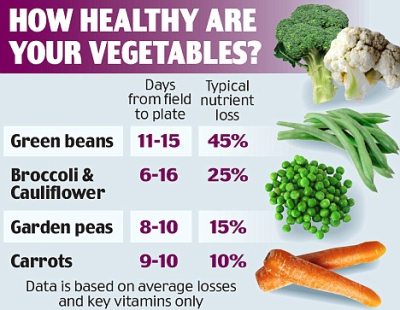 You
can grow the world's most nutritious produce, then lose most of the
vitamins and minerals before that food gets to your plate. I
picked up many of
Jerry Minnich's tips for preparing, cooking, and storing produce at my
mother's knee, but others are new to me. I
figured I'd share them all in case your mothers weren't as
health-conscious.
You
can grow the world's most nutritious produce, then lose most of the
vitamins and minerals before that food gets to your plate. I
picked up many of
Jerry Minnich's tips for preparing, cooking, and storing produce at my
mother's knee, but others are new to me. I
figured I'd share them all in case your mothers weren't as
health-conscious.
Eat
your food as soon as possible. My favorite method of
cooking
a meal is to wander out into the garden, grab a bowlful of fresh
vegetables, then cook them up immediately. Since fruits and
vegetables begin to lose nutritional quality the moment they leave the
vine, it's best not to pick your crops in the morning then cook them up
in the evening, or toss them in the fridge to be dealt with over the
weekend. In fact, this probably explains by grocery store produce
feels so dead in my mouth --- the plants have been losing vitamins and
minerals for days between the farmer's field and my table, and very
little nutrition is left.
Never
let your food wilt.
If you must store your food for some length of time before eating it,
put it in the fridge immediately rather than leaving it out in the sun
or on a hot counter. One study showed that kale lost 89% of its
vitamin C when left at 70 F for two days after picking, compared to 5%
for kale stored just above freezing for that same period 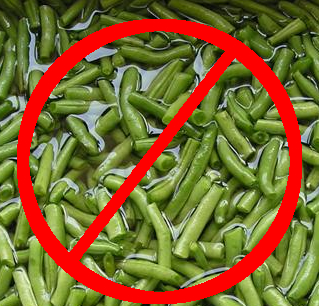 of
time.
On the other hand, a few crops are better stored outside the fridge
unless your kitchen is unusually hot --- okra, cucumbers, green beans,
peppers, eggplant, and tomatoes are shocked by cold temperatures and
lose more nutrients in the chill.
of
time.
On the other hand, a few crops are better stored outside the fridge
unless your kitchen is unusually hot --- okra, cucumbers, green beans,
peppers, eggplant, and tomatoes are shocked by cold temperatures and
lose more nutrients in the chill.
Wash
food using as little water as possible.
Many vitamins are water-based, so if you fill a bowl with water, pour
in your green beans, and pluck out one bean at a time over the next
hour while stringing them, you've lost most of those beans'
nutrition.
With produce from my own garden, I don't wash anything unless I see
dirt, and even then try to swipe the offending particle with a cloth
rather than submerging the food in water. I figure a little dirt
is good for you. (Don't follow this procedure with grocery store
produce, of course!)
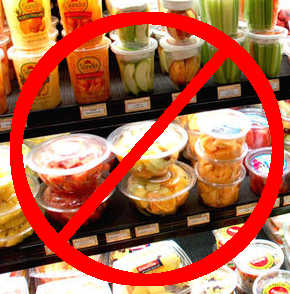 Cut your food at the last minute.
When any part of a vegetable except its protective skin is exposed to
air, the vegetable loses nutrients rapidly. So, those bite-sized
baby carrots in a bag at the grocery store? Probably pretty
nutritionally empty. In your own house, you can wait to cut up
fruits and vegetables until just before dumping them into the frying
pan or onto your plate.
Cut your food at the last minute.
When any part of a vegetable except its protective skin is exposed to
air, the vegetable loses nutrients rapidly. So, those bite-sized
baby carrots in a bag at the grocery store? Probably pretty
nutritionally empty. In your own house, you can wait to cut up
fruits and vegetables until just before dumping them into the frying
pan or onto your plate.
Eat
the skins.
In many
fruits and vegetables, vitamin C, niacin, riboflavin, and vitamin A are
concentrated in the skins, so don't peel anything. Those same
skins are usually high in fiber, which everyone knows is good for you.
Cook
food quickly and away from water.
The best ways to cook your food for nutrient preservation are steaming,
pressure cooking (at least it's over fast), sauteing or stir
frying. If 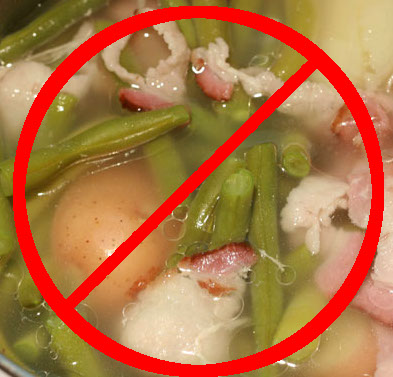 you
really feel the need to boil your green beans for
three hours with a hunk of bacon, you shouldn't even consider them
vegetables. As a side note, Jerry Minnich also recommends cooking
only in stainless steel, glass, cast iron, enamel, or lined copper pots.
you
really feel the need to boil your green beans for
three hours with a hunk of bacon, you shouldn't even consider them
vegetables. As a side note, Jerry Minnich also recommends cooking
only in stainless steel, glass, cast iron, enamel, or lined copper pots.
Don't
store your food.
Once you've chopped and cooked your food, the nutrients are
fleeting. After a day in the fridge, they're probably gone, so
try to cook only as much vegetables as you'll eat at one sitting.
(Meats, cheeses, and grains lose much less nutrition upon storage, so
these make better leftovers.)
Don't
add salt.
Salt in your cooked vegetables expedites loss of nutrients.
Apply
the same theories when preserving your food.
Anything
that can be stored in a root cellar is best stored there (with
the rare exception of potatoes, which are more nutritious but also more
prone to sprouting if stored between 50 and 60 F.) After root
cellaring, freezing
is usually the best way to preserve nutrients, but
be sure to steam blanch, cool without 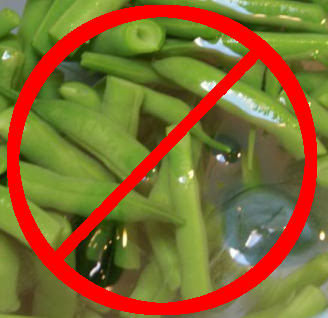 submerging in water, and
freeze
at the coldest possible temperature. The long cooking time
required for canning results in the loss of three times the nutrients
lost during freezing, so increase the pressure to 15 pounds for all produce
and decrease the processing time accordingly. Store your canned
goods in a cool, dark place (where they will not lose any more
nutrients --- a year later, canned goods might actually be higher in
nutrients than produce in an old freezer where the temperature is 30 F
instead of the recommended 0 F.) Finally, drying is probably the
worst way to preserve your food since you lose significant quantities
of vitamins C, B, A, and thiamine, especially if you use sulfur.
In all types of food processing, keep the time from vine to larder as
short as possible.
submerging in water, and
freeze
at the coldest possible temperature. The long cooking time
required for canning results in the loss of three times the nutrients
lost during freezing, so increase the pressure to 15 pounds for all produce
and decrease the processing time accordingly. Store your canned
goods in a cool, dark place (where they will not lose any more
nutrients --- a year later, canned goods might actually be higher in
nutrients than produce in an old freezer where the temperature is 30 F
instead of the recommended 0 F.) Finally, drying is probably the
worst way to preserve your food since you lose significant quantities
of vitamins C, B, A, and thiamine, especially if you use sulfur.
In all types of food processing, keep the time from vine to larder as
short as possible.
| This post is part of our Gardening for Maximum Nutrition lunchtime
series.
Read all of the entries: |
Want more in-depth information? Browse through our books.
Or explore more posts by date or by subject.
About us: Anna Hess and Mark Hamilton spent over a decade living self-sufficiently in the mountains of Virginia before moving north to start over from scratch in the foothills of Ohio. They've experimented with permaculture, no-till gardening, trailersteading, home-based microbusinesses and much more, writing about their adventures in both blogs and books.
Want to be notified when new comments are posted on this page? Click on the RSS button after you add a comment to subscribe to the comment feed, or simply check the box beside "email replies to me" while writing your comment.

I have to ask if some of the cooking in water just releases the vitamins rather than destroying them. ie soup, the veggies and meats are boiled for a while, but you eat the liquid too.
I think I remember that boiling is actually good for releasing the nutrients in bones, and this is the reason that soups are so nutritious.
That's a really good question, and I don't actually know the answer. I suspect that at least some of the nutrients are still present in the water, and I tend to think of soups as good for you even though they are boiled. When I was a kid, my mom always used to drink the water she'd boiled her greens in for that very reason.
I'd love to hear from someone else who knows better, or who takes the time to research it!